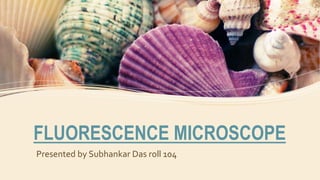
Fluorescence microscope by Subhankar Das
- 1. FLUORESCENCE MICROSCOPE Presented by Subhankar Das roll 104
- 2. What is Fluorescence microscopy ? A fluorescence microscope is an optical microscope that uses fluorescence and phosphorescence instead of, or in addition to, reflection and absorption to study properties of organic or inorganic substances.
- 3. HISTORY In 1845 herschel reported the first observation of the fluorescence of a quinine solution (extracted from chnchona tree bark) in sunlight. It is a natural crystalline alkaloid that is sensitive to uv light and under a black light it glows blueish.
- 4. WHY FLUORESCENCS MICROSCOPE ? High resolution High contrast It gives us proper understanding of the different regions inside the cells. This techniques are useful for seeing structures and measuring physiological and biochemical events in living cells.
- 5. Fluorescence Many substance absorb light of particular wavelength and energy, after absorbing they emit light of larger wave length called fluorescence. The longer the wavelength the lower the energy The shorter the wavelength the higher the energy e.g. UV light from sun causes the sunburn not the red visible light
- 6. PRINCIPLE 1. Energy is absorbed by the atom which becomes excited. 2. The electron jumps to a higher energy level. 3. Soon, the electron drops back to the ground state, emitting a photon (or a packet of light) - the atom is fluorescing
- 7. PARTS Light source: - This is provided by a bright mercury vapour lamp. This produce light rays in the range of 200-400 nm and visible rays in the range of above 780nm. Heat Filter:- The rays produced by the lamp generate considerable heat and certain rays (infra red) which are of no use in fluorescence. Heat filter is placed in front of the lamp and before the condenser to absorb heat. However, heat filter does not prevent the transmission of UV and the visible rays. Exciter filter:- The light cooled down by the heat filter next passes through the exciter filter which absorbs all but shorter waves that are need to excite the fluorescent dye coated specimen on the slide. The filters which are dark allow only green, blue, violet or UV rays.
- 8. PARTS Dichroic Filters: - It is a mirror that reflects one range of wavelengths and allows another range to pass through. Condenser: For best results, always a dark field condenser is used because in a dark background even mild fluorescence can easily be detected. Objective lens: - The objective lens collects the fluorescent-wavelength light produced. Barrier filter: - This is situated in the body tube of the microscope between the objective and the ocular lens to remove all the remnants of the exciting light so that only the fluorescence is seen. Ocular lens: - It is the lenses through which image of the microscopic object is observed. Depending upon magnification the eye piece is of four types:- 6x, 10x, 15x, 20x CCD camera: One or two ccd camera can be installed to capture the specimen image.
- 10. DICHORIC MIRROR Dichroic Filters: - It is a mirror that reflects one range of wavelengths and allows another range to pass through.
- 11. DYE Most commonly used fluorescent dyes are fluorescein, auramine A, acridine orange, rhobdamine etc.
- 12. Stroke Shift In1852 Stokes observed that the fluorescing light has longer wavelengths than the excitation light, a phenomenon that has become to be known as the Stokes shift.
- 13. JABLONSKI DIAGRAM • Jablonski diagram was first proposed by Professor Alexander Jablonski in 1935 to describe absorption and emission of light. • Upon absorbing a photon of excitation light, usually of short wavelengths, electrons may be raised to a higher energy. (10-15s). • After going to the higher energy there is a gap that is referred to as internal conversion (10-12s). • Quantum efficiency: is the ratio between the absorbed and emitted photon. • Dye should have a high QE.
- 14. IMMUNOFLUORESCENCE Antibodies to which the fluorescent dye is attached are referred to as labeled antibodies. When bacterial cells are incubated with labeled antibodies; the fluorescent dye-antibody conjugate will cover the surface of the cells. The excess fluorescent dye-antibody conjugate is washed off Preparation is observed under fluorescence microscope. The bacterial cell will glow brilliantly as a result of fluorescence. The cells not covered by the dye do not fluoresce and hence are not visible by the technique. This procedure is known as the fluorescent antibody technique and the phenomenon is termed immunofluorescence.
- 15. IMMUNOFLUORESCENCE Direct Indirect
- 16. PHOTOBLEACHING Photobleaching is the irreversible decomposition of the fluorescent molecules in the excited state because of their interaction with molecular oxygen prior to emission Methods for countering photobleaching • Scan for shorter times • Use high magnification, high objective Lens • Use wide emission filters • Reduce excitation intensity • Use “antifade” reagents (not compatible with viable cells)